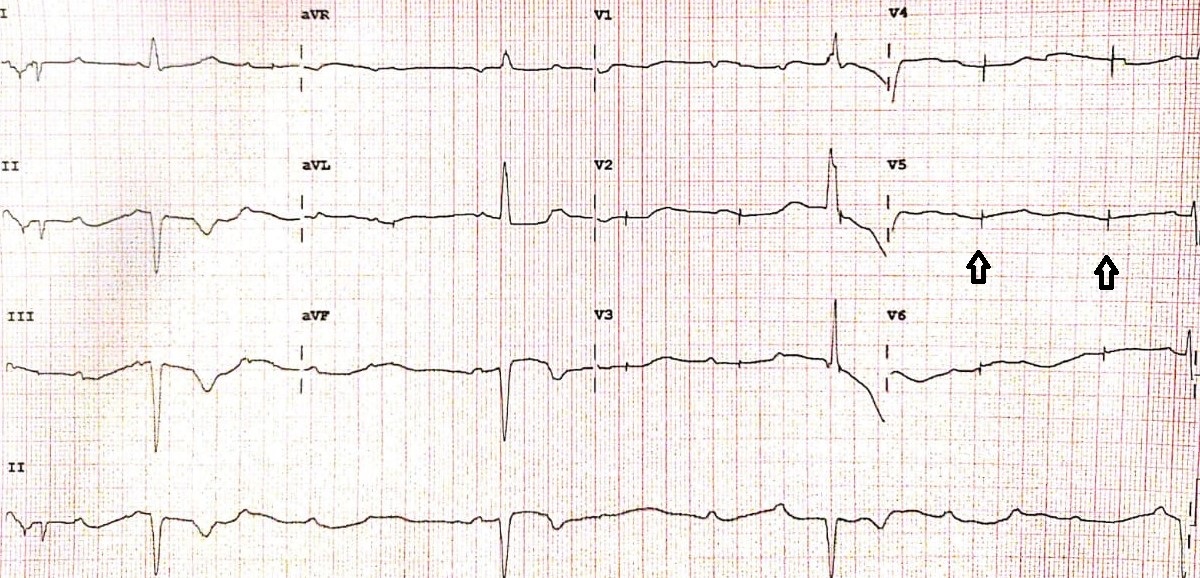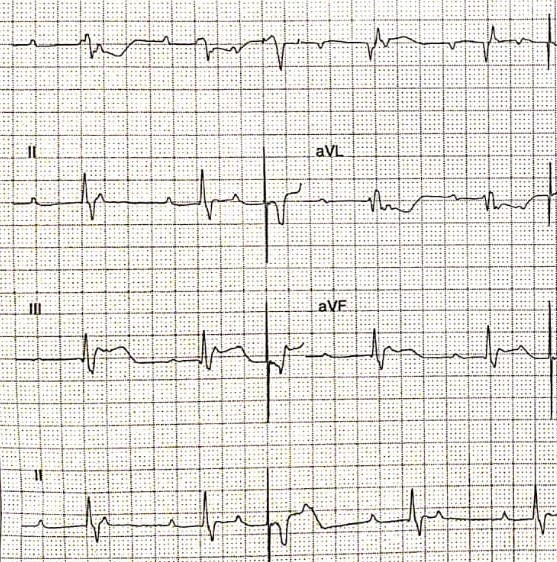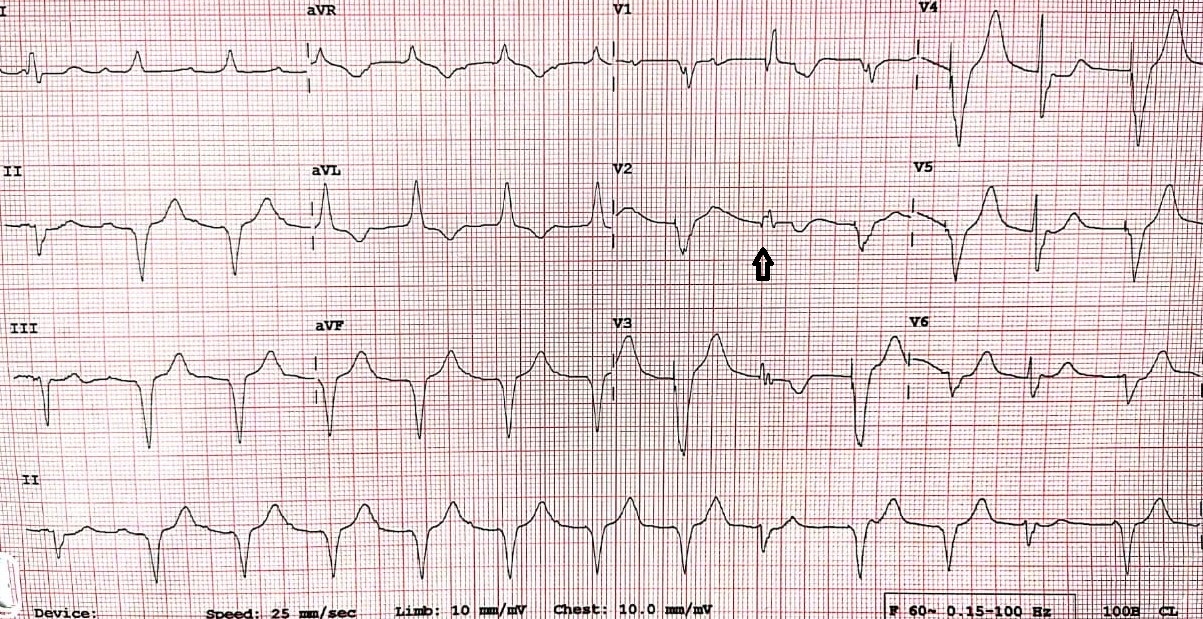[1]
Kennedy A, Finlay DD, Guldenring D, Bond R, Moran K, McLaughlin J. The Cardiac Conduction System: Generation and Conduction of the Cardiac Impulse. Critical care nursing clinics of North America. 2016 Sep:28(3):269-79. doi: 10.1016/j.cnc.2016.04.001. Epub 2016 Jun 22
[PubMed PMID: 27484656]
[2]
Anderson RH, Yanni J, Boyett MR, Chandler NJ, Dobrzynski H. The anatomy of the cardiac conduction system. Clinical anatomy (New York, N.Y.). 2009 Jan:22(1):99-113. doi: 10.1002/ca.20700. Epub
[PubMed PMID: 18773472]
[3]
James TN. Normal variations and pathologic changes in structure of the cardiac conduction system and their functional significance. Journal of the American College of Cardiology. 1985 Jun:5(6 Suppl):71B-78B
[PubMed PMID: 3998335]
[4]
Kusumoto FM, Schoenfeld MH, Barrett C, Edgerton JR, Ellenbogen KA, Gold MR, Goldschlager NF, Hamilton RM, Joglar JA, Kim RJ, Lee R, Marine JE, McLeod CJ, Oken KR, Patton KK, Pellegrini CN, Selzman KA, Thompson A, Varosy PD. 2018 ACC/AHA/HRS Guideline on the Evaluation and Management of Patients With Bradycardia and Cardiac Conduction Delay: A Report of the American College of Cardiology/American Heart Association Task Force on Clinical Practice Guidelines and the Heart Rhythm Society. Journal of the American College of Cardiology. 2019 Aug 20:74(7):e51-e156. doi: 10.1016/j.jacc.2018.10.044. Epub 2018 Nov 6
[PubMed PMID: 30412709]
Level 1 (high-level) evidence
[5]
Cingolani E, Goldhaber JI, Marbán E. Next-generation pacemakers: from small devices to biological pacemakers. Nature reviews. Cardiology. 2018 Mar:15(3):139-150. doi: 10.1038/nrcardio.2017.165. Epub 2017 Nov 16
[PubMed PMID: 29143810]
[6]
Cantillon DJ, Dukkipati SR, Ip JH, Exner DV, Niazi IK, Banker RS, Rashtian M, Plunkitt K, Tomassoni GF, Nabutovsky Y, Davis KJ, Reddy VY. Comparative study of acute and mid-term complications with leadless and transvenous cardiac pacemakers. Heart rhythm. 2018 Jul:15(7):1023-1030. doi: 10.1016/j.hrthm.2018.04.022. Epub
[PubMed PMID: 29957188]
Level 2 (mid-level) evidence
[9]
Boink GJ, Christoffels VM, Robinson RB, Tan HL. The past, present, and future of pacemaker therapies. Trends in cardiovascular medicine. 2015 Nov:25(8):661-73. doi: 10.1016/j.tcm.2015.02.005. Epub 2015 Feb 20
[PubMed PMID: 26001958]
[11]
Atlee JL, Bernstein AD. Cardiac rhythm management devices (part II): perioperative management. Anesthesiology. 2001 Dec:95(6):1492-506
[PubMed PMID: 11748411]
[12]
Sabbagh E, Abdelfattah T, Karim MM, Farah A, Grubb B, Karim S. Causes of Failure to Capture in Pacemakers and Implantable Cardioverter-defibrillators. The Journal of innovations in cardiac rhythm management. 2020 Feb:11(2):4013-4017. doi: 10.19102/icrm.2020.110207. Epub 2020 Feb 15
[PubMed PMID: 32368374]
[13]
Wang YP, Chen BX, Su KJ, Sun LJ, Zhang Y, Guo LJ, Gao W. [Hyperkalemia-induced failure of pacemaker capture and sensing: a case report]. Beijing da xue xue bao. Yi xue ban = Journal of Peking University. Health sciences. 2014 Dec 18:46(6):980-2
[PubMed PMID: 25512296]
Level 3 (low-level) evidence
[14]
Nguyên UC, Crijns HJGM. Undersensing, asynchronous pacing, and ventricular fibrillation. Europace : European pacing, arrhythmias, and cardiac electrophysiology : journal of the working groups on cardiac pacing, arrhythmias, and cardiac cellular electrophysiology of the European Society of Cardiology. 2019 Jul 1:21(7):1078. doi: 10.1093/europace/euz009. Epub
[PubMed PMID: 30726912]
[16]
Topf A, Motloch LJ, Kraus J, Danmayr F, Mirna M, Schernthaner C, Hoppe UC, Strohmer B. Exercise-related T-wave oversensing: an underestimated cause of reduced exercise capacity in a pacemaker-dependent patient-a case report and review of the literature. Journal of interventional cardiac electrophysiology : an international journal of arrhythmias and pacing. 2020 Oct:59(1):67-70. doi: 10.1007/s10840-019-00698-6. Epub 2020 Jan 23
[PubMed PMID: 31974858]
Level 3 (low-level) evidence
[17]
Boriani G, Biffi M, Schwarz T, Dong Y, Koenig A, Temporin S, Meyer S, Sperzel J. Evaluation of fusion beat detection with a new ventricular automatic capture algorithm in ICDs. Pacing and clinical electrophysiology : PACE. 2005 Jan:28 Suppl 1():S263-6
[PubMed PMID: 15683511]
[18]
Sweesy MW, Batey RL, Forney RC. Crosstalk during bipolar pacing. Pacing and clinical electrophysiology : PACE. 1988 Nov:11(11 Pt 1):1512-6
[PubMed PMID: 2462232]
[19]
Singh M, McCoy C, Daniels J. Ventricular Safety Pacing Triggered by Right Ventricular Lead Dislodgement. Circulation. 2019 Nov 19:140(21):1766-1768. doi: 10.1161/CIRCULATIONAHA.119.043267. Epub 2019 Nov 18
[PubMed PMID: 31738594]
[20]
Jastrzębski M. Pacemaker-mediated tachycardia: What is the mechanism? Pacing and clinical electrophysiology : PACE. 2018 Nov:41(11):1549-1551. doi: 10.1111/pace.13489. Epub 2018 Sep 19
[PubMed PMID: 30191581]
[21]
Alasti M, Machado C, Rangasamy K, Bittinger L, Healy S, Kotschet E, Adam D, Alison J. Pacemaker-mediated arrhythmias. Journal of arrhythmia. 2018 Oct:34(5):485-492. doi: 10.1002/joa3.12098. Epub 2018 Aug 3
[PubMed PMID: 30327693]
[22]
Ip JE, Lerman BB. Validation of device algorithm to differentiate pacemaker-mediated tachycardia from tachycardia due to atrial tracking. Heart rhythm. 2016 Aug:13(8):1612-7. doi: 10.1016/j.hrthm.2016.04.011. Epub 2016 Apr 19
[PubMed PMID: 27108937]
Level 1 (high-level) evidence
[23]
Strik M, Frontera A, Eschalier R, Defaye P, Mondoly P, Ritter P, Haïssaguerre M, Ploux S, Bordachar P. Accuracy of the pacemaker-mediated tachycardia algorithm in Boston Scientific devices. Journal of electrocardiology. 2016 Jul-Aug:49(4):522-9. doi: 10.1016/j.jelectrocard.2016.04.004. Epub 2016 Apr 22
[PubMed PMID: 27199031]
[24]
Furman S. Dual chamber pacemakers: upper rate behavior. Pacing and clinical electrophysiology : PACE. 1985 Mar:8(2):197-214
[PubMed PMID: 2580281]
[25]
Ortega DF, Sammartino MV, Pellegrino GM, Barja LD, Albina G, Segura EV, Balado R, Laiño R, Giniger AG. Runaway pacemaker: a forgotten phenomenon? Europace : European pacing, arrhythmias, and cardiac electrophysiology : journal of the working groups on cardiac pacing, arrhythmias, and cardiac cellular electrophysiology of the European Society of Cardiology. 2005 Nov:7(6):592-7
[PubMed PMID: 16216762]
[26]
Wilkoff BL, Cook JR, Epstein AE, Greene HL, Hallstrom AP, Hsia H, Kutalek SP, Sharma A, Dual Chamber and VVI Implantable Defibrillator Trial Investigators. Dual-chamber pacing or ventricular backup pacing in patients with an implantable defibrillator: the Dual Chamber and VVI Implantable Defibrillator (DAVID) Trial. JAMA. 2002 Dec 25:288(24):3115-23
[PubMed PMID: 12495391]
[27]
Steinbach K, Laczkovics A, Mohl W. [Sudden cardiac death in patients with pacemakers]. Acta medica Austriaca. 1978:5(1):1-5
[PubMed PMID: 685634]
[28]
Crossley GH, Poole JE, Rozner MA, Asirvatham SJ, Cheng A, Chung MK, Ferguson TB Jr, Gallagher JD, Gold MR, Hoyt RH, Irefin S, Kusumoto FM, Moorman LP, Thompson A. The Heart Rhythm Society (HRS)/American Society of Anesthesiologists (ASA) Expert Consensus Statement on the perioperative management of patients with implantable defibrillators, pacemakers and arrhythmia monitors: facilities and patient management this document was developed as a joint project with the American Society of Anesthesiologists (ASA), and in collaboration with the American Heart Association (AHA), and the Society of Thoracic Surgeons (STS). Heart rhythm. 2011 Jul:8(7):1114-54. doi: 10.1016/j.hrthm.2010.12.023. Epub
[PubMed PMID: 21722856]
Level 3 (low-level) evidence
[29]
Kalin R, Stanton MS. Current clinical issues for MRI scanning of pacemaker and defibrillator patients. Pacing and clinical electrophysiology : PACE. 2005 Apr:28(4):326-8
[PubMed PMID: 15826268]
[30]
Indik JH, Gimbel JR, Abe H, Alkmim-Teixeira R, Birgersdotter-Green U, Clarke GD, Dickfeld TL, Froelich JW, Grant J, Hayes DL, Heidbuchel H, Idriss SF, Kanal E, Lampert R, Machado CE, Mandrola JM, Nazarian S, Patton KK, Rozner MA, Russo RJ, Shen WK, Shinbane JS, Teo WS, Uribe W, Verma A, Wilkoff BL, Woodard PK. 2017 HRS expert consensus statement on magnetic resonance imaging and radiation exposure in patients with cardiovascular implantable electronic devices. Heart rhythm. 2017 Jul:14(7):e97-e153. doi: 10.1016/j.hrthm.2017.04.025. Epub 2017 May 11
[PubMed PMID: 28502708]
Level 3 (low-level) evidence
[31]
Russo RJ, Costa HS, Silva PD, Anderson JL, Arshad A, Biederman RW, Boyle NG, Frabizzio JV, Birgersdotter-Green U, Higgins SL, Lampert R, Machado CE, Martin ET, Rivard AL, Rubenstein JC, Schaerf RH, Schwartz JD, Shah DJ, Tomassoni GF, Tominaga GT, Tonkin AE, Uretsky S, Wolff SD. Assessing the Risks Associated with MRI in Patients with a Pacemaker or Defibrillator. The New England journal of medicine. 2017 Feb 23:376(8):755-764. doi: 10.1056/NEJMoa1603265. Epub
[PubMed PMID: 28225684]
[32]
Jung W, Zvereva V, Hajredini B, Jäckle S. Safe magnetic resonance image scanning of the pacemaker patient: current technologies and future directions. Europace : European pacing, arrhythmias, and cardiac electrophysiology : journal of the working groups on cardiac pacing, arrhythmias, and cardiac cellular electrophysiology of the European Society of Cardiology. 2012 May:14(5):631-7. doi: 10.1093/europace/eur391. Epub 2012 Jan 10
[PubMed PMID: 22237585]
Level 3 (low-level) evidence
[33]
Henrikson CA, Leng CT, Yuh DD, Brinker JA. Computed tomography to assess possible cardiac lead perforation. Pacing and clinical electrophysiology : PACE. 2006 May:29(5):509-11
[PubMed PMID: 16689847]
[34]
Platonov MA, Gillis AM, Kavanagh KM. Pacemakers, implantable cardioverter/defibrillators, and extracorporeal shockwave lithotripsy: evidence-based guidelines for the modern era. Journal of endourology. 2008 Feb:22(2):243-7. doi: 10.1089/end.2007.0021. Epub
[PubMed PMID: 18294028]
Level 1 (high-level) evidence
[35]
Thomas D, Becker R, Katus HA, Schoels W, Karle CA. Radiation therapy-induced electrical reset of an implantable cardioverter defibrillator device located outside the irradiation field. Journal of electrocardiology. 2004 Jan:37(1):73-4
[PubMed PMID: 15132373]
[36]
Kapa S, Fong L, Blackwell CR, Herman MG, Schomberg PJ, Hayes DL. Effects of scatter radiation on ICD and CRT function. Pacing and clinical electrophysiology : PACE. 2008 Jun:31(6):727-32. doi: 10.1111/j.1540-8159.2008.01077.x. Epub
[PubMed PMID: 18507546]
[37]
Marbach JR, Sontag MR, Van Dyk J, Wolbarst AB. Management of radiation oncology patients with implanted cardiac pacemakers: report of AAPM Task Group No. 34. American Association of Physicists in Medicine. Medical physics. 1994 Jan:21(1):85-90
[PubMed PMID: 8164594]
[38]
Nawa S, Shimizu N, Kino K, Hayashi K. Spontaneous secure reimplantation of a dislodged pacemaker electrode onto the right ventricular outflow tract, reestablishing a sufficient pacing condition. Clinical cardiology. 1993 Mar:16(3):267-9
[PubMed PMID: 8444003]
[39]
Favale S, Nacci F. Percutaneous transcatheter repositioning of displaced permanent pacemaker lead. Pacing and clinical electrophysiology : PACE. 1999 Dec:22(12):1817-9
[PubMed PMID: 10642138]
[40]
Eagle KA, Berger PB, Calkins H, Chaitman BR, Ewy GA, Fleischmann KE, Fleisher LA, Froehlich JB, Gusberg RJ, Leppo JA, Ryan T, Schlant RC, Winters WL Jr, Gibbons RJ, Antman EM, Alpert JS, Faxon DP, Fuster V, Gregoratos G, Jacobs AK, Hiratzka LF, Russell RO, Smith SC Jr, American College of Cardiology, American Heart Association. ACC/AHA guideline update for perioperative cardiovascular evaluation for noncardiac surgery--executive summary: a report of the American College of Cardiology/American Heart Association Task Force on Practice Guidelines (Committee to Update the 1996 Guidelines on Perioperative Cardiovascular Evaluation for Noncardiac Surgery). Journal of the American College of Cardiology. 2002 Feb 6:39(3):542-53
[PubMed PMID: 11823097]
Level 1 (high-level) evidence




